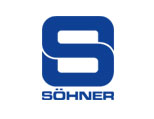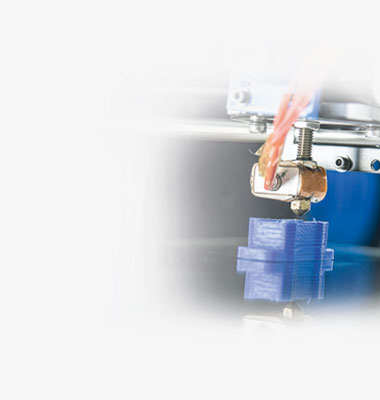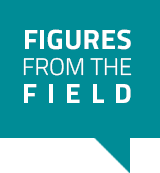


Industrial 3D printing, also known as additive manufacturing, is a process that turns digital models into a physical three-dimensional workpiece by building up material layer by layer. This differs from conventional manufacturing processes for plastics processing, such as thermoforming or injection molding, in that no tool is required to shape the plastic. Instead, the workpiece is created layer by layer on the printer’s building platform. 3D printing thus offers several advantages and is the ideal option for creating individual packaging, packaging samples and tools as well as for the production of small batches of load carriers, workpiece carriers and trays. You can find out more about our range of 3D printing services below.



With the help of rapid prototyping, we at Söhner Kunststofftechnik produce sample nests and partial cut-outs of a packaging in the FDM process extremely quickly. The same applies to the prototype of a component to be packaged if it is not available in physical form. The 3D-printed samples make it possible to identify problem areas in the geometry at an early stage and to check the functionality, handling and load-bearing capacity of a load carrier – also in combination with a component – already during a layout development. In doing so, we work closely with our customers. Your change requests flow directly and without great effort into the further development of your packaging. Only after the sample has been checked and approved is a tool for thermoforming created. In this way, we minimise the development time and save development costs in a packaging project.
Technical features in rapid prototyping
| 3D printing technology: | FDM / FFF |
| Assembly space: | up to 850 x 405 x 1396 mm |
| Tolerances: | 0.5 mm in X/Y and 0.2 mm in Z direction (standard) 0.1 mm in X/Y and 0.05 mm in Z direction (high resolution) |
| Material: | ABS, PETG, PA, PLA, TPU, TPU foam & many more |
| Sample dimensions: | up to 2400 x 1200 mm |
| Production time: | from 1 working day |
At Söhner Kunststofftechnik, we use rapid tooling as a supplement to conventional, machining tool production from solid material (aluminium). 3D printing in the FDM process is particularly suitable for the realisation of deep-drawing tools and tool inserts up to a size of 1200 x 1000 mm. Additive manufacturing offers the unique possibility to integrate internal cooling channels and "vacuum nozzles" directly into the tools of the load carriers. This eliminates the need for time-consuming reworking of the tool. At the same time, the cooling performance is improved because the channels can be incorporated in any cross-sections, radii and positions. Your added value: fast tool production, reduced cycle times and high quality packaging.
Technical features in rapid tooling
| 3D printing technology: | FDM / FFF |
| Assembly space: | up to 850 x 405 x 1396 mm |
| Material: | High-temperature thermoplastics and fiber-reinforced plastics |
| Tool dimensions: | up to 1200 x 1000 mm |
| Production time: | from 2 working days |
Not only individual pieces such as prototypes, packaging samples or tools can be realised very well in 3D printing. With the FDM process, we are also able to produce small series of packaging (with low quantities) economically. This is because, in comparison to thermoforming, the production costs for rapid manufacturing are not linked to the production of tools. The production takes place without a tool, directly and built up in a 3D printer. Due to the elimination of the tool, the small-batch production of load carriers in 3D printing is not only time-saving, but the process is also more energy-efficient and resource-saving overall than thermoformed small-batch production. It is possible to produce workpiece carriers and trays in 3D printing in dimensions from 100 x 100 mm to a maximum of 800 x 400 mm.
Technical features in rapid manufacturing
| 3D printing technology: | FDM / FFF |
| Assembly space: | up to 850 x 405 x 1396 mm |
| Tolerances: | 0.5 mm in X/Y- and 0.2 mm in Z direction (standard) 0.1 mm in X/Y- and 0.05 mm in Z direction (high resolution) |
| Material: | ABS, PETG, PA, PLA, TPU, TPU foam & many more |
| Tray dimensions: | up to 800 x 400 mm |
| Production time: | from 2-3 working days (depending on quantities) |
With the FDM process, we use state-of-the-art 3D printing technology to accelerate the development of plastic packaging and produce load carriers in a short time. We provide you with the first detailed sample nests or partial cut-outs of a packaging from the layout development stage. This allows you to check your workpiece for the correct fit andperform functional testsusing a physical load carrier model. Possible sources of error are detected at an early stage and the risk of costly design revisions and tool changes is minimized. In addition, the costs for tool production and tool setup are eliminated in this phase. Overall, 3D printing can reduce development time and costs by up to 50 percent.
| Delivery of component data | Layout development | Layout approval | Sample production | Approval |
| Delivery of 3D data | Layout development | Sample | Approval |
Fused Deposition Modeling (FDM) is a 3D printing process in which a workpiece is built up layer by layer from molten plastic, also known as Fused Filament Fabrication (FFF). To do this, the 3D model is first broken down into layers with the help of a computer program. Once this preparation step has been completed, the actual printing can begin. Plastic wire (known as filament) is fed from a spool to an extrusion head, melted and applied in layers through a nozzle onto a building platform, where it then cools and solidifies. When a layer is finished, the platform moves down and the process is repeated. This creates a material image of a digital model layer by layer. The FDM process can be used to produce solid and hollow parts from thermoplastics such as PLA, ABS or PETG. In contrast to other methods, however, solid parts are not printed as complete solids, but rather with filling structures. If the object has overhanging elements, additional support structures must be printed so that they do not break off.

Realized
3D printing projects
More than
More than
More than
3D printing requires printable 3D data. Please upload the data or a drawing of your workpiece in the form. The following file formats are suitable: .stp, stl. The maximum file size is 30 MB. Alternatively, you can also send us your workpiece and we will create the data using a 3D scanner.